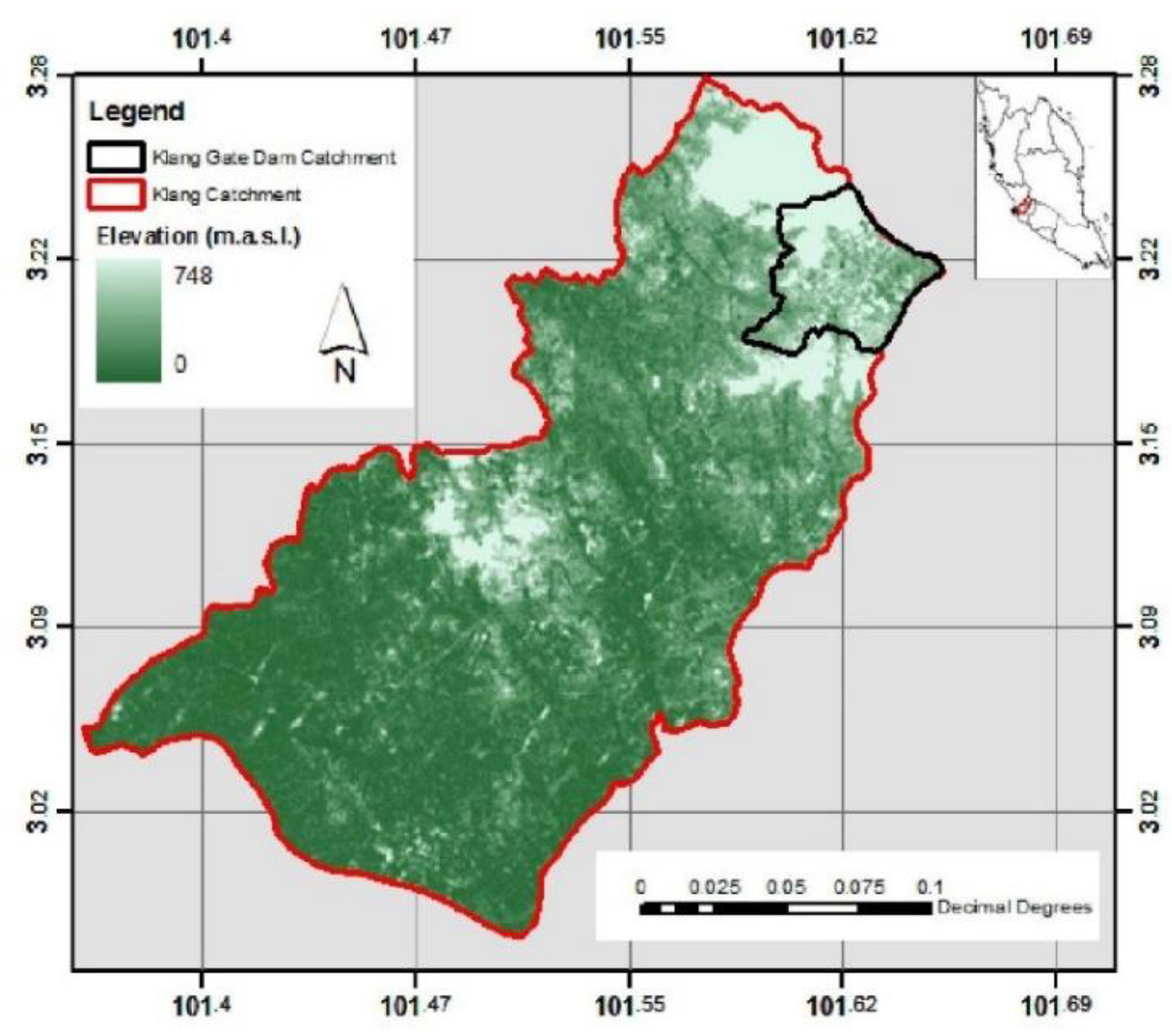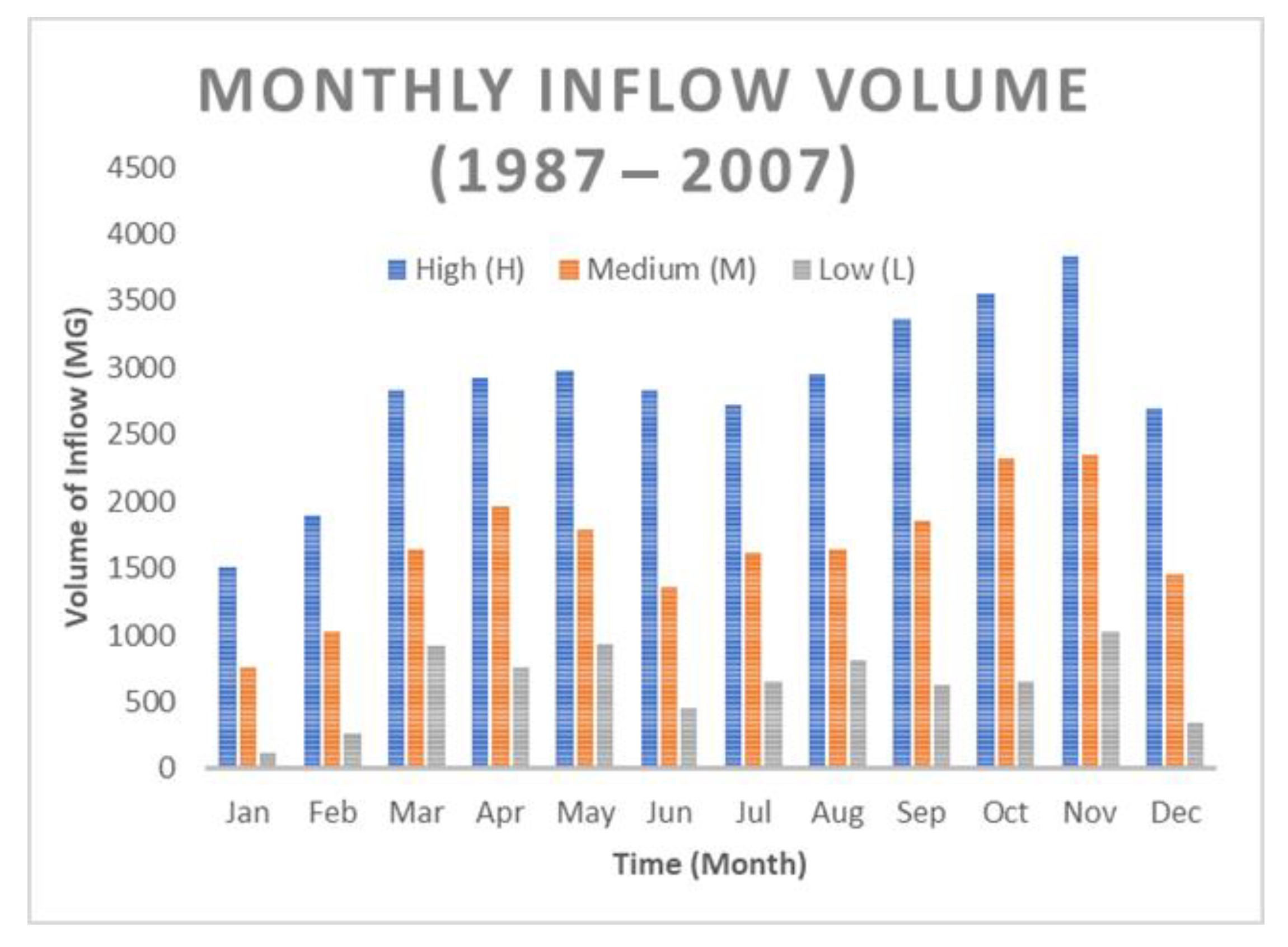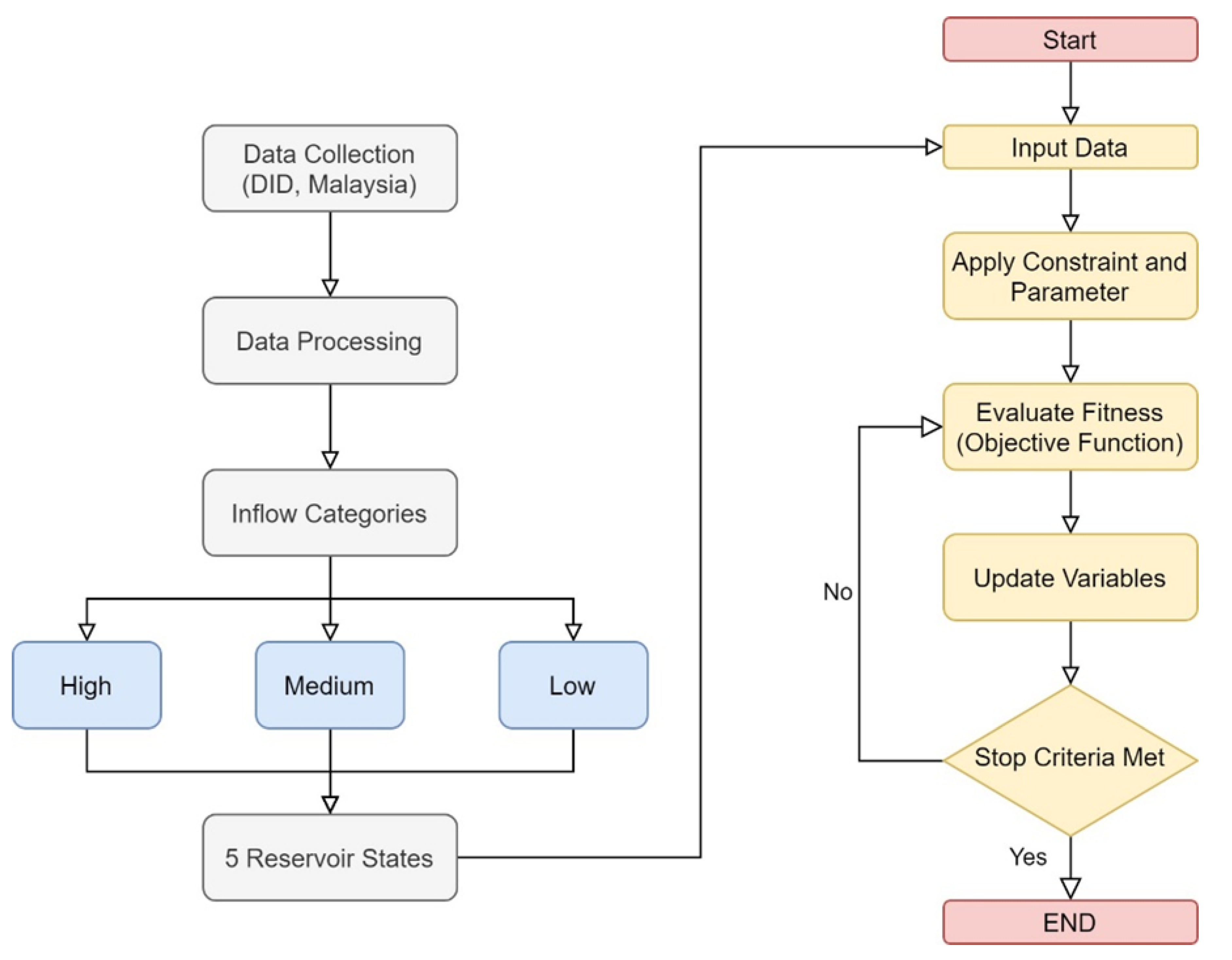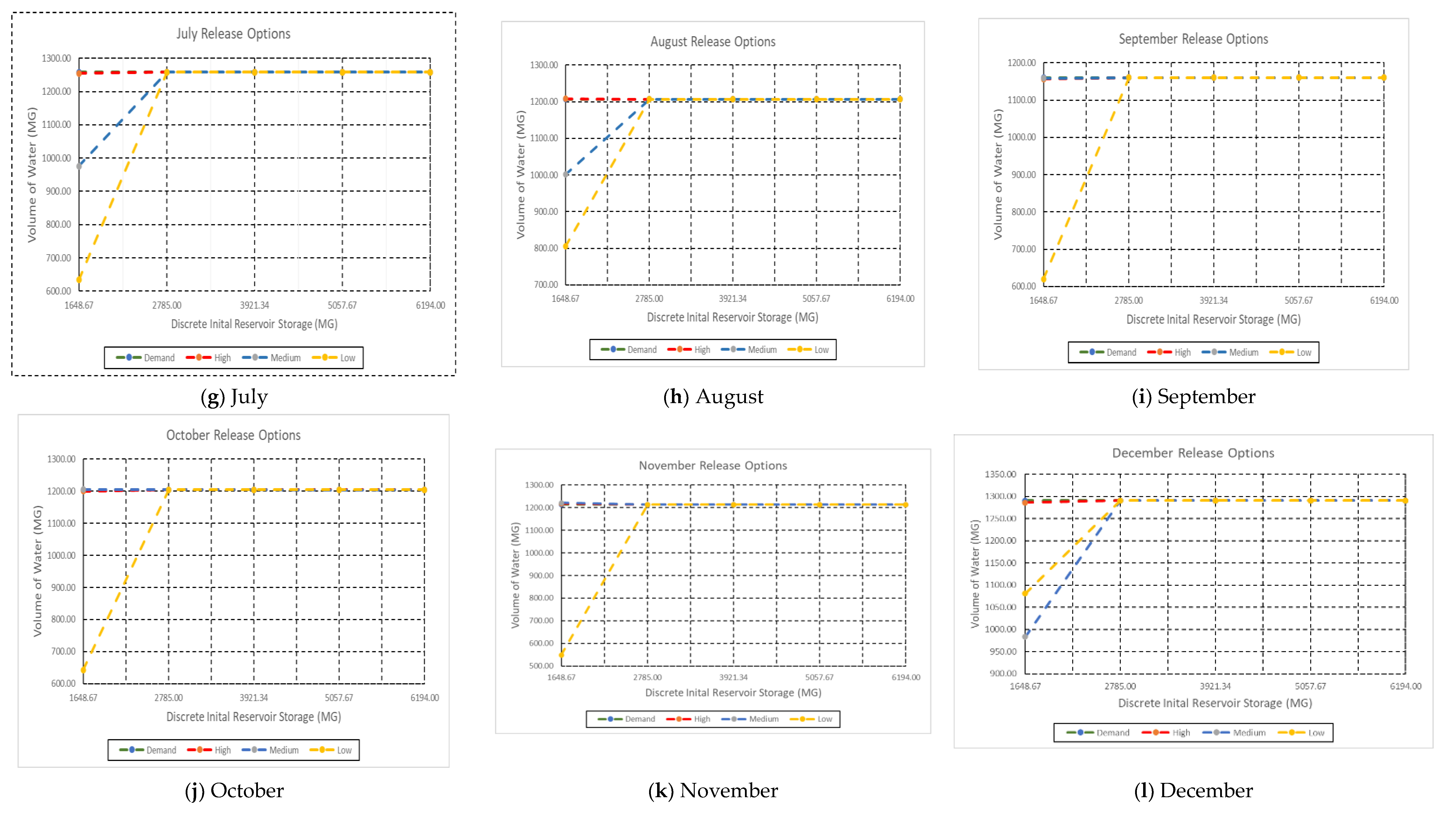3.1. Release Curves
The optimum release options for the different storage have been determined using the developed CSS algorithm as shown in
Figure 4 for each month of the year. The main aim is to develop a release curve depicting the best release policy based on the changes in the inflow. The policy is seen as the operating policy of the steady state. The optimum results in terms of reservoir storage volume and release are shown in the figures that aim to minimize the expected device output. The graphs plotted with the initial storage of reservoir versus the release per unit of demand for each month in different states are for a high, medium, and low state.
Figure 4a shows the optimal release policies for January. In the figure, the model failed to meet the demand during high, medium, and low inflow at a low storage level, 1648.67 MG. The demand is then met when the storage level is 2785 MG for all inflow categories. The release only failed to meet the demand at 1648.67 MG storage for all inflow categories for January. For February, the optimal release policies are shown in
Figure 4b. The release only failed to meet the demand during the medium and low inflow at 1648.67 MG storage from the figure. The rest of the figure shows that the release managed to fulfill the demand needed.
Following the obtained results from
Figure 4, it can be concluded that the developed optimization technique proposed a reliable decision to release water to meet the demand for the entire twelve months and during different inflow scenarios. However, during high and medium inflow, the proposed model exhibits high performance in optimizing the release of water to meet the demand downstream. With regards to low inflow, the optimized release policy did not always meet the demand, especially during the initial storage, which is naturally hard to supply water up to the demand level when there is low storage.
To validate the reliability of the proposed model, a comparison between the findings and the different optimization algorithms was carried out. Hossain and El-shafie [
37] developed different optimization techniques using the same current study area. Therefore, the following section demonstrates the performance of the proposed SCC model with the findings from the published study by Hossain and El-shafie [
37].
In order to compare the RMSE of the release curve between the model algorithms, an equation was used to denote the release policy error for all inflow groups. Errors are represented as a percentage of demand in
Figure 5. The values of RMSE are taken to measure the mean error of the release curves in terms of demand. The mean error is defined in Equation (23).
Figure 5 shows the optimal operating policies from January to December. In this paper, the inflow is categorized into high, medium, and low inflow types. This inflow is obtained from average rainfall from the year 1987 to the year 2007. The inflow is measure using Equation (1) and calculated into monthly inflow for 12 months. For each inflow category, five different states of reservoir storage level are applied for this model algorithm. The model algorithm in this study is charged system search (CSS).
Overall,
Figure 5 shows that the release only failed to meet the demand when the storage level was low, at 1648.47 MG. Some of the inflow in high and medium categories managed to fulfill the demand during low storage level; however, there are times when high and medium inflow could not meet the demand, especially for a low category. Other than that, the reservoir met the demand for the rest of the storage level for all inflow categories.
As a result, it indicates that the reservoir is able to fulfill the demand needed for all inflow categories at a storage level of 2785 MG within the reservoir constraints.
Figure 5 shows the error of the release policies for all inflow categories. The charged system search (CSS) algorithm has the lowest error in high inflow compared with ABC, PSO, real coded GA, and binary GA algorithms. For medium inflow, CSS has the highest error of release than other algorithms. The CSS algorithm has the third-lowest error rate, while the real coded GA and ABC algorithm has lower error rates than CSS. It can be seen that charged system search (CSS) is the most accurate model with the closest values to demand for high inflow and the less accurate model for medium inflow.
3.2. Reliability and Risk Analysis
The simulation results were examined from different points of view in order to perform risk analysis and model comparison. The following section provides information about the root mean square error (RMSE), reliability, resilience, and vulnerability of each optimized release policy according to the proposed model results compared with the other previously published models.
The calculated RMSE values for every month are obtained by using Equation (17) as shown in the methodology section. The RMSE values are calculated for three types of inflows: high, medium, and low for CSS, ABC, PSO, real coded GA, and binary GA.
The RMSE values for each of the optimizers for the three pre-defined inflows can be seen in
Table 5. It can be seen that the lowest average RMSE value among all optimizers was found to be associated with the proposed CSS model during high inflow events. Such findings suggest that CSS can be more reliable in dealing with extreme events such as heavy rainfall events, which is very common in Malaysia. Is also can be concluded that the proposed algorithm outperformed all other models scientifically for the high inflow. However, overall, all the models have similar performances during the three different inflow classes combined, which is still acceptable.
Reliability indicates the frequency of a model’s success and failure, with regard to meeting the demands. In the case of the KGD, in 12 months, five storage states and three inflow types were considered as the total operational period. A total of 180 results (release amounts) were obtained from each optimization model. The periodic reliability was measured by using Equation (19).
The number of releases fulfilled the demand required for high, medium, and low inflow, which each consist of five states of storage. Overall, the reservoir can meet the demand of about 81.67% from 180 total releases in 12 months, as shown in
Table 6. It can be seen from the obtained results that the proposed model for low inflow met the demand more than 80% and never exceeded the demand. For medium inflow, similar performance was achieved when the proposed model met more than 80% of the water demand downstream of the reservoir. Similar robust performance was achieved during the high inflow events. Such performance confirms the reliability of the proposed model for optimizing the release policy to achieve the demand without violating any defined constraints.
Finally, we gauged the robustness of the proposed model using a different set of measures. In this study, performance measurements were conducted to check the reliability, resiliency, sustainability, and vulnerability of the model algorithm, charged system search (CSS), for overall performance for KGD, as can be seen in
Table 7. In terms of reliability, the proposed model exhibits a high-reliability percentage for the three different inflow scenarios, which ranges between 93.75% and 99.43%. In terms of resiliency, it can be seen that the proposed release policy from the CSS model is capable of recovering from failure during different inflow events. A low vulnerability indicator was found when the proposed model was used to optimize the release policy in this case study. Finally, in terms of how sustainable the proposed model is, a sustainability index measurement was calculated for the different defined inflow classes, which shows that the proposed model is reliable in dealing with any inflow changes that occur and can be used as sustainable tools for optimizing the release from the reservoir efficiently.
In summary, based on the release curves, reliability, and risk analysis, charged system search (CSS) proves to be applicable in optimizing the dam’s operation. Charged system search generates the operating rule in monitoring the reservoir’s release in order to meet the demand. The CSS algorithm resulted in lower error rates for release policies in high inflow than ABC, PSO, real coded GA, and binary GA algorithms. By using charged system search (CSS), about 81.67% of the demands are met in all inflow categories for 180 releases in 12 months. The reliability (Rv) and reliability (Rp) for the CSS algorithm are high, proving that the algorithm has high stability. Overall, the charged system search (CSS) algorithm is applicable in minimizing the release policy to obtain a minimum difference between target release and actual demand.
Therefore, it can be concluded that the charged system search (CSS) algorithm can be adopted as a reliable tool for operating the Klang Gates dam since it outperformed the previously developed algorithms. However, there is a need to investigate other optimization techniques that were recently developed by other researchers and exhibit promising results. For instance, the Jaya algorithm (JA) was recently proposed to optimize the operation policy of a hydropower reservoir [
24]. They found that the JA technique outperformed other selected algorithms compared with searching for the best solution. In addition to that, recently, different advanced optimization techniques are proposed as robust techniques to be used in searching for the best solution in dealing with water resources issues [
26]. For example, the waterdrop optimization technique [
38], the whale optimization algorithm [
39], the ant lion optimization algorithm [
40], the nomadic people optimization algorithm [
41], the Harris hawks optimization algorithm [
42], and the grey wolf optimization technique [
27]. Therefore, future work could be carried out to develop these recent optimization techniques and explore their performances in optimizing the release from the reservoir to meet the downstream demand.















